Anger greeted news Wednesday that hereditary Wet’suwet’en chiefs brokered a peaceful end to a potentially violent pipeline standoff in northern B.C.
Leader Freda Huson stormed out of a closed-door meeting at the Unist’ot’en camp south of Houston, B.C., and slammed the door.
She just learned chiefs promised the RCMP she and her partner Warner Naziel would abide by rules of an interim court injunction in exchange for calling off a police raid.
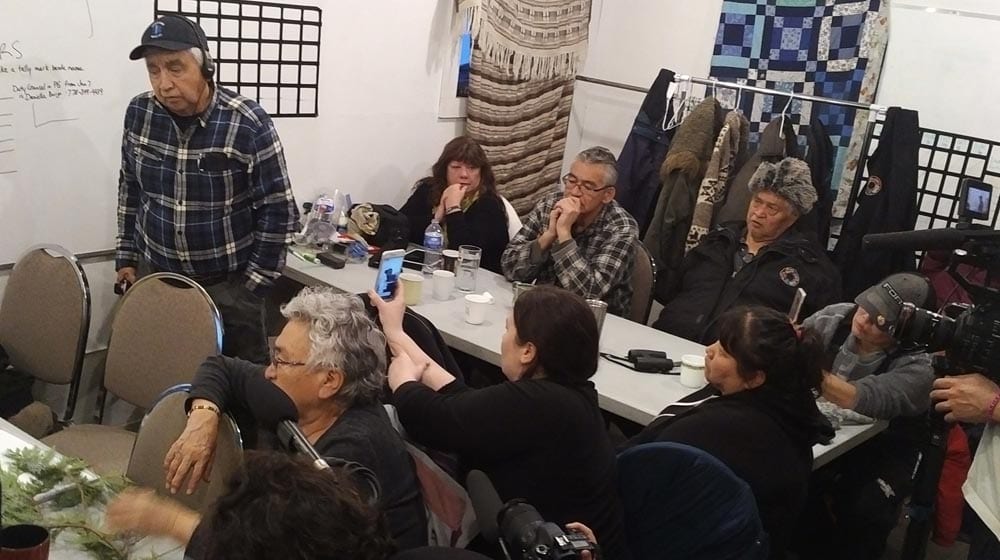
Chiefs wanted to prevent a repeat of Monday when heavily RCMP officers stormed a checkpoint on sister clan Gidimt’en territory and arrested 14 people.
The homemade barricades blocking pipeline company Coastal GasLink, a subsidiary of Trans-Canada, from crossing the Morice River bridge were next before chiefs stepped in.
“CGL will receive soft access,” Chief Na’Moks told reporters, who were allowed into the room to hear details of the agreement after about two hours.
“I don’t have any respect for them,” Nam’oks added of the Calgary-based company.
“If I seem upset, you better believe we are.”
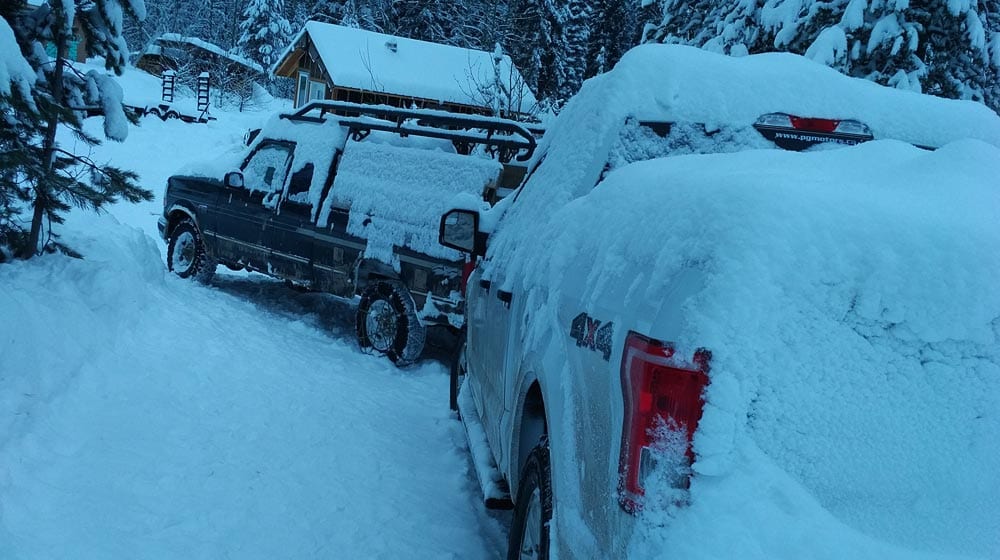
(Trucks parked on the road leading to the Unist’ot’en healing centre to block access. Photo: Kathleen Martens/APTN)
In a tentative agreement worked out between the RCMP and Wet’suwet’en hereditary chiefs Wednesday evening, the nation made three demands to Brenda Butterworth-Carr, deputy commissioner of the RCMP in B.C. who is a member of the Tr’ondëk Hwëch’in Han Nation, Yukon.
In part, that the RCMP immediately remove the exclusion area to allow access for media and others, confirm that RCMP officers will not interfere with any Wet’suwet’en members accessing their territory for trapping or other traditional practices, confirm that officers will not enter the healing centre and will engage with the Wet’suwet’en Nation to work on a protocol for access to the healing centre that will protect members from pro-pipeline protestors and Coastal GasLink employees.
The meeting then heard the RCMP’s reply.
“I commit to you that the RCMP will remain respectful of the healing centre,” said the response from the RCMP. “Our officers will not enter the healing centre unless invited and we will work with you to ensure that others are respectful of your centre.
“Further, the RCMP will not interfere with your members access to the territory for the purposes of trapping and or traditional practices. I will also restate our commitment to the respect the right of peaceful, lawful and safe protest.”
The tentative agreement would have the Unist’oten camp remove the barrier and allow workers from Coastal GasLink through the site by 2 p.m. on Thursday. Talks Thursday may go past that time.
Huson didn’t return to the meeting in the centre’s dining room that stretched into the late afternoon.
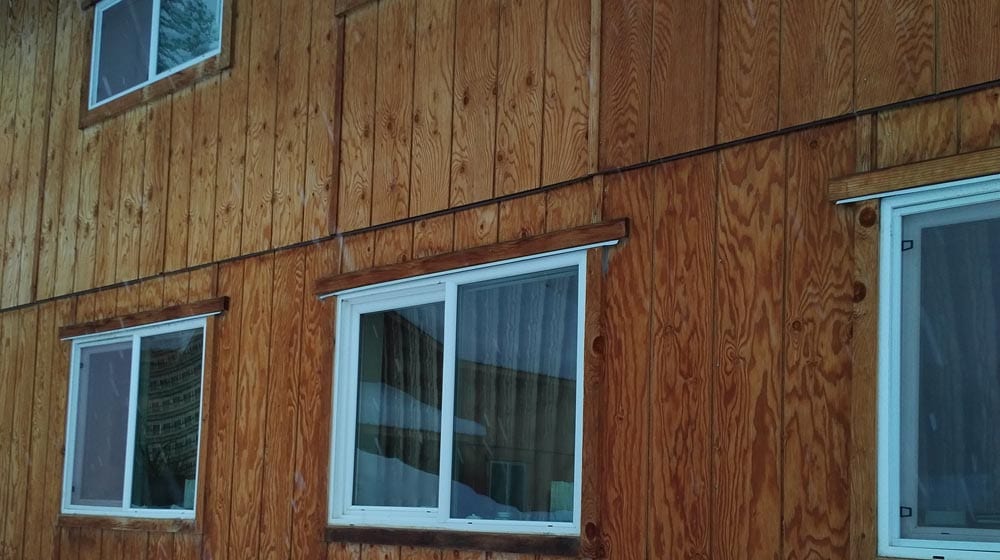
(The healing centre at the Unist’ot’en camp. Photo: Kathleen Martens/APTN)
The windows in the room were covered with sheets and blankets to prevent police from being able to see or shoot inside, said Brenda Michell, a Wet’suwet’en woman staying at the camp and niece of Unistot’en hereditary Chief Knedabeas.
She said the peace agreement was a surprise and didn’t know how to react, except to say opening the gate to contract workers worried her.
She asked the chiefs, who spent Tuesday night and Wednesday morning negotiating with RCMP, to amend the agreement at a meeting scheduled with police Thursday, to keep the gate locked and opened only when CGL workers arrived.
“The gate is protecting us from the outside,” she said. “I can sleep at night knowing it’s there.”
Michell and others at the camp looked exhausted.
They were girding for a police raid when Knedabeas arrived instead with three members of an RCMP liaison team and news reporters, including a two-person team from APTN News.
It was the second surprise in as many nights.
Michell said they were stunned Tuesday when people who “escaped” the Gidimt’en raid pounded on the door.
“We were all in shock when they managed to come back here,” she said, not revealing how many there were.
“We were relieved and happy to see them.”
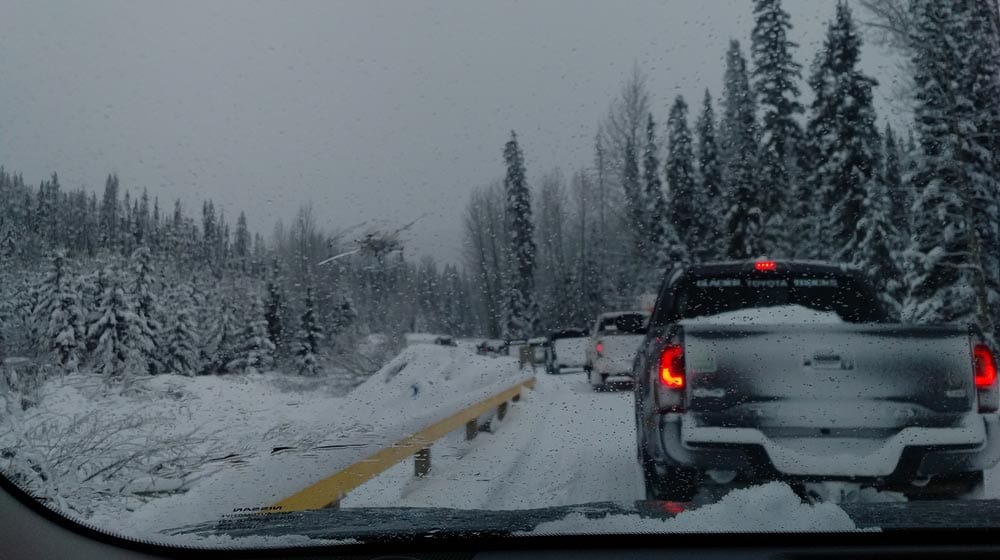
(A convoy on the Morice River road includes hereditary chiefs, media and RCMP. Photo: Kathleen Martens/APTN)
Reporters were told escapees were in bad shape mentally but there were trained people at the healing centre to help them.
Na’Moks said avoiding any further trauma to more people is why chiefs made the deal.
“We want media here to witness our agreement with the RCMP,” he said.
But the camp refused to divulge its wifi password, preventing most media outlets, including APTN from reporting what was happening until returning to Houston later.
It was another of the hurdles media faced in covering the story that generated headlines around the world.
On Monday, RCMP barred reporters from gaining access to the Gidimt’en checkpoint by erecting a roadblock about 20 kilometres away. Media who were already behind the lines were allowed to stay.
The roadblock opened briefly Wednesday to allow the chiefs’ convoy through to camp, although Mounties stopped each vehicle to record the names of people inside and their licence numbers.
The roadblock was at a site without cellular phone service, so reporters couldn’t relay information to their newsrooms or post on social media.
Supporters of the roadblock and camp built a fire and shelter outside the roadblock that quickly became a meeting place.
That’s where chiefs initially planned to announce the peace agreement Wednesday morning before deciding to make the hour-long drive to the healing centre that saw one media outlet end up in the ditch and miss the news conference.
When the convoy reached Gidimt’en checkpoint it was reporters’ first opportunity to see the aftermath of Monday’s raid.
There were felled trees pushed off the road – scattered branches, a jacket and backpacks left behind, and the red plywood gate some protesters reportedly tied themselves to was thrown in the ditch.
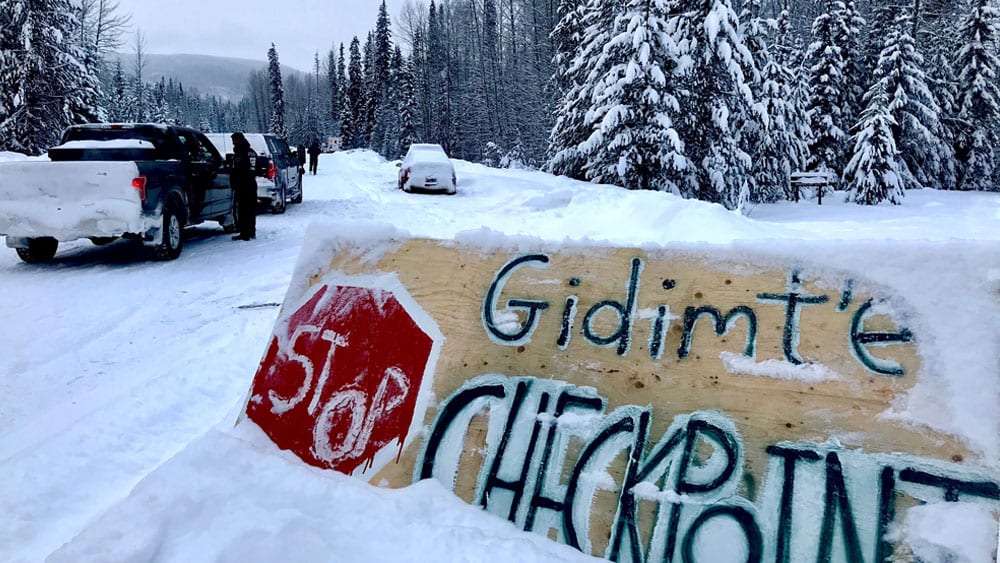
(The Gidimt’en sign at the checkpoint on January 9. Photo: Simon Charland/APTN)
The Gidimt’en signs were still up and shelters remained standing, which followed the judge’s instructions in the interim injunction granted Dec. 14, 2018.
A canvas cook tent that caught fire was still there, showing char marks on one wall.
Gidimt’en supporters said everyone arrested Tuesday was released from custody by Wednesday night.
Upon reaching the camp, Na’Moks appeared overcome with emotion as he stopped in the snow to survey the narrow bridge over the Morice River.
A large, vertical sign declaring ‘Unist’ot’en’ in black and white caught his attention, as did three vehicles, including a dump truck, parked on the bridge to stop police.
Knedabeas was visibly angry and quizzed people operating the gate.
“Why are these here?” he said of the vehicles.
“That wasn’t the plan.”










Thank you so much for your on-site coverage of this crucial confrontation. Although the RCMP raid traumatized the First Nations people standing up to them, we, the public, need to hear much more about the greater harm the First Nations are trying to prevent in terms of the fracked gas pipeline, the LNG project and its many harms: harms to the land during construction; the frequency with which gas pipelines rupture, leak and cause fires that must burn out; the fact that methane is more harmful to climate than even CO2 (methane is 86 to 105 times more potent in terms of global warming than CO2 in the 20-year time frame); as well as harms to wildlife and the First Nations themselves. Please include this background as much as possible in future coverage and we appreciate your work to give accurate, up to the minute on-site coverage under adverse conditions.
Thank you so much for your on-site coverage of this crucial confrontation. Although the RCMP raid traumatized the First Nations people standing up to them, we, the public, need to hear much more about the greater harm the First Nations are trying to prevent in terms of the fracked gas pipeline, the LNG project and its many harms: harms to the land during construction; the frequency with which gas pipelines rupture, leak and cause fires that must burn out; the fact that methane is more harmful to climate than even CO2 (methane is 86 to 105 times more potent in terms of global warming than CO2 in the 20-year time frame); as well as harms to wildlife and the First Nations themselves. Please include this background as much as possible in future coverage and we appreciate your work to give accurate, up to the minute on-site coverage under adverse conditions.